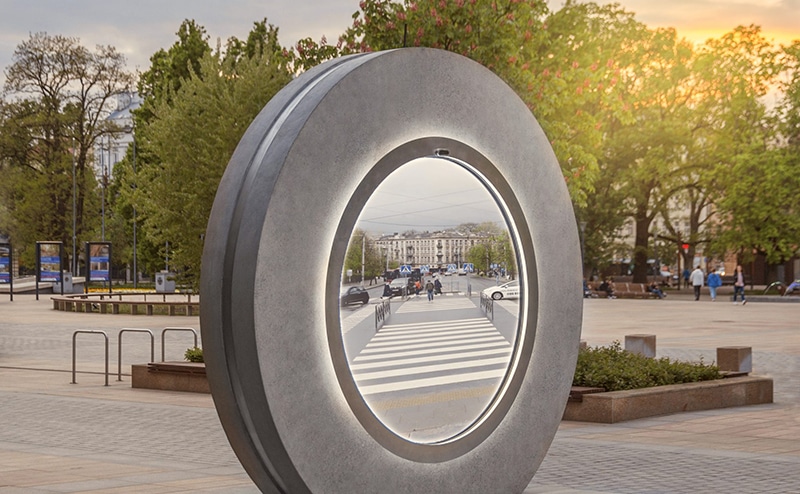Introduction
The Portal connecting Dublin and New York City has restarted after a brief pause earlier this week. This unique project aims to unite people across the Atlantic, offering a blend of art and technology that fosters global connections.
The Concept Behind the Portal
Imagine standing in Dublin and being able to wave hello to someone in New York City in real time. That’s the magic of the Portal. Lithuanian artist Benediktas Gylys created these two large circular sculptures with screens in the center. They’re like giant digital windows that let you interact with people across the ocean.
In Dublin, the Portal stands on O’Connell Street, giving you a view of the General Post Office (GPO) and the Spire. In New York, it’s set up at the busy Flatiron South Public Plaza, right where Broadway, Fifth Avenue, and 23rd Street meet. Both spots are perfect for locals and tourists alike to stop by and say hi to someone far away.
How the Portal Works
These sculptures aren’t just cool pieces of art—they’re also high-tech. Inside each one is a setup that streams live video and audio between the two cities, letting you see and hear each other as if you were standing side by side. The system runs on Video Windows software provided by AVI-SPL, with cameras capturing everything in real time.
The Role of Public Art in Technology
What makes the Portal special is how it combines art with cutting-edge technology. It’s a reminder that art can do more than just look pretty—it can also bring people together in new and exciting ways. The Portal encourages people to step out of their daily routines and connect with someone from a completely different place.

Challenges and Adjustments
Of course, not everything has gone smoothly. After it first opened, there were some incidents of inappropriate behaviours. Dublin City Council had to turn off the live stream temporarily. They’ve now set specific hours for the Portal to operate: 6 am to 4 pm in New York and 11 am to 9 pm in Dublin. Plus, they’ve added some tech to blur the screen if anyone tries to misuse the Portal again.
Public Reception and Impact
Despite these hiccups, the Portal has been a big hit. Tens of thousands of visitors have checked it out, and it’s even racked up nearly two billion impressions online. Most people feel a sense of joy and connection when they use the Portal. It’s amazing to see how a piece of art can make people feel closer, even when they’re miles apart.
Enhanced Security Measures
To keep things running smoothly, there are now more security measures in place. In New York, there’s on-site security during all operating hours. They’ve also added fences, signs, and markers to help manage crowds and make sure everyone knows where to stand for the best experience.
Artist’s Vision
Benediktas Gylys, the mind behind the Portal, sees it as a way to bring people together, no matter where they’re from. “Portals are an invitation to meet people above borders and differences and to experience our world as it really is—united and one. The livestream provides a window between distant locations, allowing people to meet outside of their social circles and cultures, transcend geographical boundaries, and embrace the beauty of global interconnectedness,” he said.
Gylys believes that technology can be a force for good, and the Portal project is a perfect example of how art and tech can create meaningful connections.
The Future of the Portal
Looking ahead, the Portal project could expand to other cities around the world, creating a global network of these digital windows. Each new location would add its unique vibe, making the experience even richer. Plus, as technology improves, the Portal could get even more interactive and immersive.
Conclusion
The Portal project is a shining example of how art and technology can bring people together. With the new measures in place, it’s back in action, proving that public art can connect us in ways we never imagined. The Portal is more than just a sculpture; it’s a symbol of our shared desire to connect and understand each other, no matter where we are in the world.
As the project continues to grow, it will keep inspiring and engaging people, showing us all the beauty of our global community. So next time you’re near one of the Portals, take a moment to look through it—you never know who you might meet on the other side.

